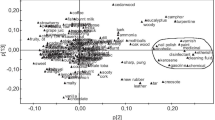Abstract
The concept of shape space, which has been successfully implemented in immunology, is used here to construct a model for the discrimination power of the olfactory system. Using reasonable assumptions on the behaviour of the biological system, we are able to estimate the number of distinct olfactory receptor types. Our estimated value of around 1000 receptor types is in good agreement with experimental data.
Similar content being viewed by others
References
Arstila, T. P., A. Casrouge, V. Baron, J. Even, J. Kanellopoulos and P. Kourilsky (1999). A direct estimate of the human αβ T cell receptor diversity. Science 286, 958–961.
Borghans, J. A. M., A. J. Noest and R. J. De Boer (1999). How specific should immunological memory be? J. Immunol. 163, 569–575.
Cohen, I. R. (2000). Tending Adam’s Garden, Academic Press.
De Boer, R. J. and A. S. Perelson (1991). Size and connectivity as emergent properties of developing immune network. J. Theor. Biol. 149, 381–424.
Detours, V., R. Mehr and A. S. Perelson (1999). A quantitative theory of affinity-driven T cell repertoire selection. J. Theor. Biol. 200, 389–403.
Janeway, C. and P. Travers (1997). Immunobiology: the Immune System in Health and Disease, 3rd edn, Current Biology Ltd., Garland.
Keşmir, C., J. A. M. Borghans and R. J. De Boer (2000). Diversity of human αβ T cell receptors. Science 288, 1135a.
Kohonen, T. (1997). Self-organizing Maps, 2nd edn, Springer.
Lancet, D., E. Sadovsky and E. Seidemann (1993). Probability model for molecular recognition in biological receptor repertoires: Significance to the olfactory system. Proc. Natl. Acad. Sci. 90, 3715–3719.
Mori, K. and Y. Yoshihara (1998). Molecular recognition and olfactory processing in the mammlian olfactory system. Prog. Neurobiol. 13, 479–493.
Perelson, A. S. and G. F. Oster (1979). Theoretical studies of clonal selection: Minimal antibody repertoire size and reliability of self-non-self discrimination. J. Theor. Biol. 81, 645–670.
Perelson, A. S. and G. Weisbuch (1997). Immunology for physicist. Rev. Mod. Phys. 69, 1219–1267.
Perelson, A. S. and F. W. Wiegel (1999). Some design principles for immune system recognition. Complexity 4, 29–37.
Segel, L. A. and A. S. Perelson (1988). Computations in shape space: a new approach to immune network theory, in Theoretical Immunology Part Two, SFI Studies in the Sciences of Complexity, A. Perelson (Ed.), Addison-Wesley Publishing Company, pp. 321–343.
Smith, D. J., S. Forrest, R. R. Hightower and A. S. Perelson (1997). Deriving shape space parameters from immunological data. J. Theor. Biol. 189, 141–150.
Weisbuch, G. (1990). A shape space approach to the dynamics of the immune system. J. Theor. Biol. 143, 507–522.
Weisbuch, G. and M. Oprea (1994). Capacity of a model immune network. Bull. Math. Biol. 56, 899–921.
Author information
Authors and Affiliations
Rights and permissions
About this article
Cite this article
Carmel, L., Harel, D. & Lancet, D. Estimating the size of the olfactory repertoire. Bull. Math. Biol. 63, 1063–1078 (2001). https://doi.org/10.1006/bulm.2001.0259
Received:
Accepted:
Issue Date:
DOI: https://doi.org/10.1006/bulm.2001.0259




